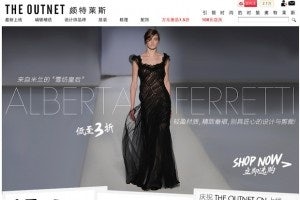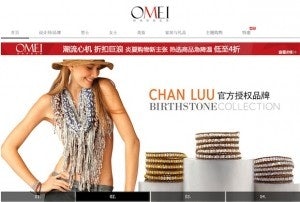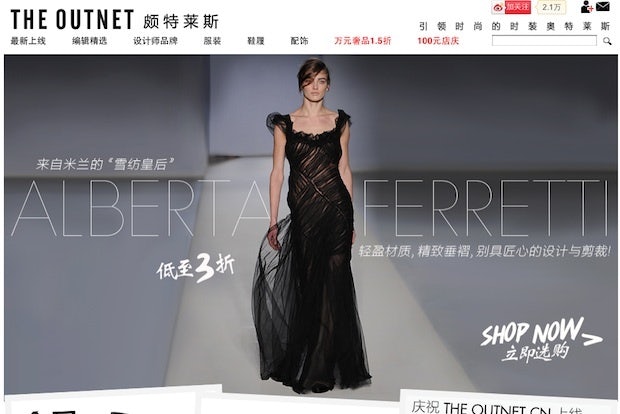Macy’s, Neiman Marcus, Net-A-Porter Adapt "O2O" (Online-to-Offline) Model For China#

Last year, Jing Daily predicted that China's nascent luxury e-commerce market, following massive investment by domestic and international companies in 2011, would see continued growth in 2012 but a broader industry shakeout due to overcrowding and undersupply. As Reuters noted shortly thereafter, China’s e-commerce market, “once the darling of private equity and venture capital firms,” was set for a period of intense competition for exactly the same reasons. Now, less than a year later, these prediction are being realized as e-tailers -- fighting for market share and to secure better and more stable supply lines while also offering the discounts and perks demanded by Chinese shoppers -- are finding it increasingly difficult to stay afloat, let alone turn much of a profit.
The contentious market is having a disproportionately heavy effect on upstart Chinese platforms, which, absent the stronger relationships with major luxury brands enjoyed by their global competitors, are finding it harder to stay afloat. Following in the footsteps of the late NetEase Premier, the first casualty of the luxury e-commerce shakeout (which shuttered in January after less than one year), many domestic Chinese e-tailers are either downsizing or closing shop altogether. Over the past year, the closing of Wooha.com was followed by deep cuts in staff at Shangpin.com and the resignation of VIPKu’s CEO. As Technode recently pointed out, luxury-focused B2C site Jiapin.com may be next on the chopping block, with rumors swirling that the site may shut down in the near future.

Disenchanted with the inherent challenges of China's luxury e-commerce market, many e-tailers are seeking solutions to combat low profit margins and ways to take advantage of still-high demand for luxury goods among China's middle class. The country remains the world's second-largest luxury market, after all, and though many luxury consumers do a significant portion of their shopping on overseas vacations, landlocked shoppers in inland China (and shoppers looking for brands that are otherwise hard to find in their hometowns) remain key demographics for luxury e-tailers.
Yet demand itself isn't the problem -- it's supply. Concerned about a loss of brand image, domestic Chinese e-tailers find it difficult to secure stock from major luxury brands which they then have to deeply discount. As such, these retailers have no way to guarantee stock, price or quality to potential shoppers in China. Mix that in with long lead times, and the result is this year's well-anticipated industry shakeout.
However -- perhaps having watched these developments over the past several years -- some international luxury retailers may be moving in the right direction. Adopting a comparatively new e-commerce model,
O2O#
-- Online to Offline commerce, an “authentic and full-price” business model -- retail giant
Macy’s#
has invested US$15 million in the domestic Chinese online retailer VIPStore and is on track to launch sales on VIPStore’s luxury site,
Omei.com#
, in spring 2013, delivering “original priced” goods that are timely, exclusive, and readily available.

As Jing Daily noted this past spring, American luxury retail group
Neiman Marcus#
is also set to kick off its own China expansion with a US$28 million investment in the privately held e-commerce company Glamour Sales Holding by the end of this year. Similarly,
Net-A-Porter Group Limited#
, the UK online luxury fashion retailer, acquired the Chinese members-only discount e-tailer
Shouke.com#
back in February and, shortly thereafter, launched a Chinese version of its "Outnet," offering a higher-end set of designers and labels as well as discounted items.
The Shouke/Net-A-Porter partnership, along with Neiman Marcus and Macy’s, may have a fighting chance in China’s cutthroat market if they stick to an O2O model. (Or at least adapt it to suit their business goals, as is the case with The Outnet.) Unlike the "race to the bottom" strategy employed by home-grown Chinese luxury e-tail hopefuls, O2O-focused sites can offer in-season collections at more profitable price-points, experiment with capsule collections featuring hard-to-find designers or up-and-coming Chinese names and labels, offer richer content featuring behind-the-scenes videos and exclusive editorial content, and highlight fashion advice and expertise.
These features, paired with the greater "cred" enjoyed by far more established names like the 105-year-old Neiman Marcus, means that foreign O2O e-tailers have the potential to capture a somewhat more sophisticated, wealthier, and more discriminating niche luxury consumer in China than their local counterparts, which continue to battle it out for thinner profit margins. At the same time, pairing with companies from the Greater China region, like VIPStore, Glamour Sales and Shouke, makes for a valuable shortcut to learn about, target, and profit from the local Chinese consumer. On the face of it, O2O looks like a smart strategy for success in a tough Chinese luxury e-commerce market -- albeit one we'll have to watch closely in the year ahead as it remains, for the most part, uncharted waters in China.
